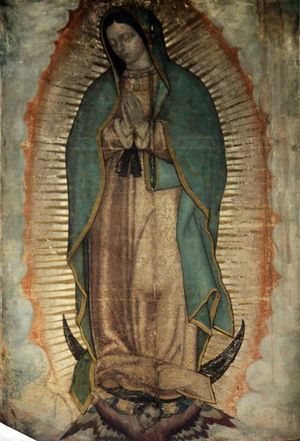As Catholics celebrate the Dec. 8 Feast of the Immaculate Conception and the Dec. 9-12 anniversary of Our Lady of Guadalupe's appearances in 1531, let's consider the ways we honor our goddesses.
For instance. Another tradition dating from the 16th century holds that Mary, mother of Jesus, appeared in Velankanni, India, to perform miraculous healings; the region also boasts an ancient temple of the prosperity goddess Lakshmi, wife of Vishnu. Anatolia's Ephesus, a long-established cult site of the goddess Artemis, gained the unlikely reputation of being a post-crucifixion home to Mary. In the Andes, Mary's statuary robes were designed to resemble a mountain peak in tribute to a local fertility deity, the Pachamama. Similar joinings of Mary with indigenous goddesses have occurred all over the world. It's called syncretism.
Colonialist Christians didn't like syncretism, but they needed Mary. Lacking the kind of partner goddess featured in most religions, monotheistic Christianity found it easier to tolerate pagans' equation of the Greek Zeus with God the Father, for instance, or the Roman Mithras with Jesus, than to accept Artemis as a surrogate for Mary, who was not a god.
Hellenized Christianity, far from worshiping any female god, held low tolerance for women in general, banning them from the priesthood and emphasizing Eve's prompting role in the decisive sin of Adam. But the conventions of the conquered forced a compromise, as exemplified by the doctrine of the Immaculate Conception, which holds that God let Mary emerge from her mother's womb untainted by the original sin that burdens the rest of us, and therefore worthy to bear the god-man herself. That advantage pushed Mary close to divinity, and most of the world reveres her as not precisely a god, but the Mother of God.
In Mexico, the Virgin of Guadalupe became a touchstone of colonial conflict. She represented an Indio appropriation of the conquerors' saint: Her famous image was created by an indigenous painter, and her appearance to a peon in a high elevation of Mexico associated her with the oppressed and with the mountain goddess. Like Mexican depictions of Jesus, which emphasize the Savior's bloodied and buried aspects, the Virgin of Guadalupe could be construed as a vehicle for reclaiming ancestral power. But due to her immediate and persistent popularity, the conquistadors' church had no choice but to enshrine her.
Happy winter solstice.
* * *
Christopher Garcia, an expert in ancient Mesoamerican instruments, recommends (and participates in) Evelina Fernandez's yearly pageant play about the Virgin of Guadalupe at the Cathedral of Our Lady of the Angels, 555 W. Temple St., downtown 90012; 7:30pm; free, or get reserved seats for $40; details and tix here.
Faith is a wonderful thing. A musician whose name I have not been able to discover (don't know enough Spanish) has laid the original image of the Virgin of Guadalupe on its side, drawn a music staff across it, and used the stars and flowers on its robe as notes. This has resulted in a composition that can combine beauty with dissonance when played with sufficient reverence on piano, or produce an ethereal mood when artfully arranged.

